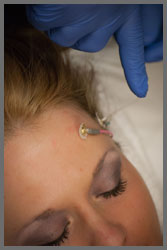Electroencephalography (EEG)
Test Overview
 The brain has constant electrical activity flowing through it to tell our body what to do. Electroencephalography (EEG) measures the electrical activity made by the brain. Measuring the electrical activity in the brain can help detect the presence and extent of diseases that can alter the brain’s electrical activity such as seizures or other brain dysfunction. The actual site of damage or disease can often be located. Recording leads are placed all throughout the scalp. This is non invasive (does not break the skin) and does NOT involve needles or probes.
The brain has constant electrical activity flowing through it to tell our body what to do. Electroencephalography (EEG) measures the electrical activity made by the brain. Measuring the electrical activity in the brain can help detect the presence and extent of diseases that can alter the brain’s electrical activity such as seizures or other brain dysfunction. The actual site of damage or disease can often be located. Recording leads are placed all throughout the scalp. This is non invasive (does not break the skin) and does NOT involve needles or probes.
Why It Is Done
- EEG is done to help diagnose problems that could cause different altered mental statuses such as seizures and also help direct medication therapy and monitor for response to medication.
- EEG is performed in “real time” which means it records ongoing brain wave activity for as briefly as 30 minutes (routine EEG) up to 72 hours (Ambulatory EEG).
How to Prepare
Routine EEG
- Inform your doctor of any medications you are taking. Some medications can interfere with EEG results.
- Inform your doctor if you have dentures, partials or wear contact lenses. These can interfere with testing. If you have glasses, please wear those at time of testing.
- Hair products and oil interfere with the study. On the day of the study, please arrive with clean, dry hair and scalp. All braids, weaves, and hair pieces must be removed prior to testing.
- Please bring a comb or hat for after the test.
- EKG electrodes will be placed; we recommend a button down shirt or loose fitting T shirt be worn.

Ambulatory EEG
Please follow all preparations for the routine EEG including strong preference for a button down shirt.
